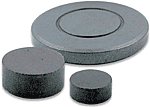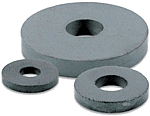 |
 |
||||||||||
|
|
|||||||||||
|
|
Toll Free:
|
||||||||||||||||||||||||||||||||||||||||||||||||||||||||
| CERAMIC
MAGNETS Ceramic (ferrite) permanent magnets are composed of strontium carbonate and iron oxide. They are charcoal gray in color and usually appear in the forms of discs, rings, blocks, cylinders, and sometimes arcs for motors. Attributes of Ceramic Magnets
Applications of Ceramic Magnets |
 Ceramic Blocks |
||||||||||||||||||||||||||||||||||||||||||||||||||||||||
 Ceramic Discs |
|||||||||||||||||||||||||||||||||||||||||||||||||||||||||
 Ceramic Rings |
|||||||||||||||||||||||||||||||||||||||||||||||||||||||||
| Typical Magnetic and Physical Properties of Ceramic Magnet Material
|
|||||||||||||||||||||||||||||||||||||||||||||||||||||||||
| All magnet materials demonstrate
reversible strength loss as they approach Maximum Operating Temperature. Tolerances Magnetizing and Handling Machining |
|||||||||||||||||||||||||||||||||||||||||||||||||||||||||
Copyright © ALL Magnetics Inc Tel: 714-632-1754 Address: 2831 Via Martens, Anaheim, CA 92806 |